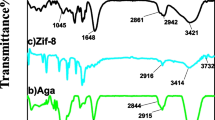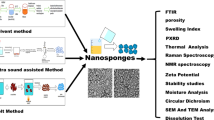Abstract
The aim of present research aims to fabricate a system of enteric coating of hydrogel beads with pH-sensitive polymer, which shows solubility at pH > 7, and explore their potential to target the colon for drug delivery. Hydrogel beads were fabricated through the extrusion-dripping technique followed by ion gelation crosslinking. Moreover, freeze-thaw cycle was implemented for crosslinking of polyvinyl alcohol (PVA)/Ca-alginate blend beads. The oil-in-oil solvent evaporation method was adopted for the Eudragit coating of hydrogel beads using different coat: core ratios (4:1 or 8:1). Coated and uncoated hydrogel beads were evaluated by in vitro physicochemical properties, swelling and drug release behaviours, and in vivo pharmacokinetics, swelling, and toxicity evaluation. Diclofenac sodium was loaded as an experimental drug. Drug entrapment efficiency for the PVA/Ca-alginate beads was calculated as 98%, and for Ca-alginate beads, it came out to a maximum of 74%. Drug release study at various pH suggested that, unlike uncoated hydrogel beads, the coated beads delay the release of diclofenac sodium in low pH of the gastric and intestinal environment, thus targeting the colon for the drug release. It was concluded that Eudragit S-100-coated hydrogel beads could serve as a more promising and reliable way to target the colon for drug delivery.

Graphical Abstract








Similar content being viewed by others
Change history
25 March 2022
A Correction to this paper has been published: https://doi.org/10.1208/s12249-022-02244-6
References
Dhanavel S, Revathy TA, Sivaranjani T, Sivakumar K, Palani P, Narayanan V, et al. 5-Fluorouracil and curcumin co-encapsulated chitosan/reduced graphene oxide nanocomposites against human colon cancer cell lines. Polym Bull. 2020;77(1):213–33.
Nee, J., R.Z. Chippendale, and J.D. Feuerstein. Screening for colon cancer in older adults: risks, benefits, and when to stop. in Mayo Clinic Proceedings. 2020. Elsevier.
Wong RS. Role of nonsteroidal anti-inflammatory drugs (NSAIDs) in cancer prevention and cancer promotion. Adv Pharmacol Sci. 2019;2019:1–10.
Arora S, Budhiraja R. Chitosan-alginate microcapsules of amoxicillin for gastric stability and mucoadhesion. Journal of advanced pharmaceutical technology & research. 2012;3(1):68–74.
Sinha V, Kumria R. Polysaccharides in colon-specific drug delivery. Int J Pharm. 2001;224(1):19–38.
Hosseinzadeh H. Preparation of pH-sensitive carrageenan-g-poly (acrylic acid)/bentonite composite hydrogel for 5-fluorouracil controlled release in colon. Res J Pharm, Biol Chem Sci. 2011;2(2):446–56.
Gupta P, Vermani K, Garg S. Hydrogels: from controlled release to pH-responsive drug delivery. Drug Discov Today. 2002;7(10):569–79.
BEADS, H., RESEARCH ARTICLE. 2014.
Dai YN, et al. Swelling characteristics and drug delivery properties of nifedipine-loaded pH sensitive alginate–chitosan hydrogel beads. J Biomed Mater Res B Appl Biomater. 2008;86(2):493–500.
Chan E-S, Lee BB, Ravindra P, Poncelet D. Prediction models for shape and size of ca-alginate macrobeads produced through extrusion–dripping method. J Colloid Interface Sci. 2009;338(1):63–72.
Wang Q, Xie X, Zhang X, Zhang J, Wang A. Preparation and swelling properties of pH-sensitive composite hydrogel beads based on chitosan-g-poly (acrylic acid)/vermiculite and sodium alginate for diclofenac controlled release. Int J Biol Macromol. 2010;46(3):356–62.
Nochos A, Douroumis D, Bouropoulos N. In vitro release of bovine serum albumin from alginate/HPMC hydrogel beads. Carbohydr Polym. 2008;74(3):451–7.
Gombotz WR, Wee SF. Protein release from alginate matrices. Adv Drug Deliv Rev. 2012;64:194–205.
Mahmoud AA, Elkasabgy NA, Abdelkhalek AA. Design and characterization of emulsified spray dried alginate microparticles as a carrier for the dually acting drug roflumilast. Eur J Pharm Sci. 2018;122:64–76.
Bajpai S, Sharma S. Investigation of swelling/degradation behaviour of alginate beads crosslinked with Ca 2+ and Ba 2+ ions. React Funct Polym. 2004;59(2):129–40.
Hua S, Ma H, Li X, Yang H, Wang A. pH-sensitive sodium alginate/poly (vinyl alcohol) hydrogel beads prepared by combined Ca 2+ crosslinking and freeze-thawing cycles for controlled release of diclofenac sodium. Int J Biol Macromol. 2010;46(5):517–23.
Nugent MJ, Higginbotham CL. Preparation of a novel freeze thawed poly (vinyl alcohol) composite hydrogel for drug delivery applications. Eur J Pharm Biopharm. 2007;67(2):377–86.
Hassan C, Peppas N. Structure and applications of poly (vinyl alcohol) hydrogels produced by conventional crosslinking or by freezing/thawing methods. Biopolymers PVA Hydrogels, Anionic Polymerisation Nanocomposites. 2000:37–65.
Tacx J, et al. Dissolution behavior and solution properties of polyvinylalcohol as determined by viscometry and light scattering in DMSO, ethyleneglycol and water. Polymer. 2000;41(3):947–57.
Kulkarni RV, Boppana R, Krishna Mohan G, Mutalik S, Kalyane NV. pH-responsive interpenetrating network hydrogel beads of poly (acrylamide)-g-carrageenan and sodium alginate for intestinal targeted drug delivery: synthesis, in vitro and in vivo evaluation. J Colloid Interface Sci. 2012;367(1):509–17.
Paharia A, Yadav AK, Rai G, Jain SK, Pancholi SS, Agrawal GP. Eudragit-coated pectin microspheres of 5-fluorouracil for colon targeting. AAPS PharmSciTech. 2007;8(1):E87–93.
M. Obeidat, W. and J.C. Price, Preparation and evaluation of Eudragit S 100 microspheres as pH-sensitive release preparations for piroxicam and theophylline using the emulsion-solvent evaporation method. J Microencapsul, 2006. 23(2): p. 195-202.
Chawla A, Sharma P, Pawar P. Eudragit S-100 coated sodium alginate microspheres of naproxen sodium: Formulation, optimization and in vitro evaluation/Alginatne mikrosfere naproksen natrija obložene Eudragitom S-100: Priprava, optimizacija i in vitro vrednovanje. Acta Pharma. 2012;62(4):529–45.
Rodríguez M, Vila-Jato JL, Torres D. Design of a new multiparticulate system for potential site-specific and controlled drug delivery to the colonic region. J Control Release. 1998;55(1):67–77.
Rai G, Yadav AK, Jain NK, Agrawal GP. Eudragit-coated dextran microspheres of 5-fluorouracil for site-specific delivery to colon. Drug delivery. 2016;23(1):328–37.
Altman R, Bosch B, Brune K, Patrignani P, Young C. Advances in NSAID development: evolution of diclofenac products using pharmaceutical technology. Drugs. 2015;75(8):859–77.
Lorenzo-Lamosa M, et al. Design of microencapsulated chitosan microspheres for colonic drug delivery. J Control Release. 1998;52(1):109–18.
Niu B, Jia J, Wang H, Chen S, Cao W, Yan J, et al. In vitro and in vivo release of diclofenac sodium-loaded sodium alginate/carboxymethyl chitosan-ZnO hydrogel beads. Int J Biol Macromol. 2019;141:1191–8.
Choi B, et al. Preparation of alginate beads for floating drug delivery system: effects of CO2 gas-forming agents. Int J Pharm. 2002;239(1-2):81–91.
Rehman S, et al. Enteric-coated Ca-alginate hydrogel beads: a promising tool for colon targeted drug delivery system. Polym Bull. 2020:1–15.
Higuchi T. Mechanism of sustained-action medication. Theoretical analysis of rate of release of solid drugs dispersed in solid matrices. J Pharm Sci. 1963;52(12):1145–9.
Li S, Shen Y, Li W, Hao X. A common profile for polymer-based controlled releases and its logical interpretation to general release process. J Pharm Pharm Sci. 2006;9(2):238–44.
Korsmeyer RW, Gurny R, Doelker E, Buri P, Peppas NA. Mechanisms of solute release from porous hydrophilic polymers. Int J Pharm. 1983;15(1):25–35.
Zhai X-J, Yu Y, Chen F, Lu YN. Comparative bioavailability and tolerability of single and multiple doses of 2 diclofenac sodium sustained-release tablet formulations in fasting, healthy chinese male volunteers. Curr Ther Res. 2013;75:53–8.
Nerkar PP, Gattani SG. Cress seed mucilage based buccal mucoadhesive gel of venlafaxine: in vivo, in vitro evaluation. J Mater Sci Mater Med. 2012;23(3):771–9.
Murata Y, Miyamoto E, Kawashima S. Additive effect of chondroitin sulfate and chitosan on drug release from calcium-induced alginate gel beads. J Control Release. 1996;38(2-3):101–8.
Park TG, Hoffman AS. Preparation of large, uniform size temperature-sensitive hydrogel beads. J Polym Sci A Polym Chem. 1992;30(3):505–7.
Yoo MK, Choi HK, Kim TH, Choi YJ, Akaike T, Shirakawa M, et al. Drug release from xyloglucan beads coated with Eudragit for oral drug delivery. Arch Pharm Res. 2005;28(6):736–42.
Pasparakis G, Bouropoulos N. Swelling studies and in vitro release of verapamil from calcium alginate and calcium alginate–chitosan beads. Int J Pharm. 2006;323(1):34–42.
Doria-Serrano M, et al. Physical characteristics of poly (vinyl alcohol) and calcium alginate hydrogels for the immobilization of activated sludge. Biomacromolecules. 2001;2(2):568–74.
Thakral NK, Ray AR, Majumdar DK. Eudragit S-100 entrapped chitosan microspheres of valdecoxib for colon cancer. J Mater Sci Mater Med. 2010;21(9):2691–9.
Şanlı O, Ay N, Işıklan N. Release characteristics of diclofenac sodium from poly (vinyl alcohol)/sodium alginate and poly (vinyl alcohol)-grafted-poly (acrylamide)/sodium alginate blend beads. Eur J Pharm Biopharm. 2007;65(2):204–14.
Palomo M, Ballesteros M, Frutos P. Analysis of diclofenac sodium and derivatives. J Pharm Biomed Anal. 1999;21(1):83–94.
Chiew CSC, Yeoh HK, Pasbakhsh P, Poh PE, Tey BT, Chan ES. Stability and reusability of alginate-based adsorbents for repetitive lead (II) removal. Polym Degrad Stab. 2016;123:146–54.
Dainty A, et al. Stability of alginate-immobilized algal cells. Biotechnol Bioeng. 1986;28(2):210–6.
Elnashar MM, et al. Surprising performance of alginate beads for the release of low-molecular-weight drugs. J Appl Polym Sci. 2010;116(5):3021–6.
Bajpai A, Saini R. Preparation and characterization of biocompatible spongy cryogels of poly (vinyl alcohol)–gelatin and study of water sorption behaviour. Polym Int. 2005;54(9):1233–42.
Khan M, Sridhar B, Srinatha A. Development and evaluation of pH-dependent micro beads for colon targeting. Indian J Pharm Sci. 2010;72(1):18–23.
Fernandez-Hervas M, et al. In vitro evaluation of alginate beads of a diclofenac salt. Int J Pharm. 1998;163(1):23–34.
Bajpai A, Giri A. Swelling dynamics of a macromolecular hydrophilic network and evaluation of its potential for controlled release of agrochemicals. React Funct Polym. 2002;53(2):125–41.
Peppas, N., Analysis of Fickian and non-Fickian drug release from polymers. 1985.
Shukla S, Bajpai A, Kulkarni R. Preparation, characterization, and water-sorption study of polyvinyl alcohol based hydrogels with grafted hydrophilic and hydrophobic segments. J Appl Polym Sci. 2005;95(5):1129–42.
Wang H, Gong X, Guo X, Liu C, Fan YY, Zhang J, et al. Characterization, release, and antioxidant activity of curcumin-loaded sodium alginate/ZnO hydrogel beads. Int J Biol Macromol. 2019;121:1118–25.
Lin X, Miao L, Wang X, Tian H. Design and evaluation of pH-responsive hydrogel for oral delivery of amifostine and study on its radioprotective effects. Colloids Surf B: Biointerfaces. 2020;195:111200.
Etim N, et al. Haematological parameters and factors affecting their values. Agric Sci. 2014;2(1):37–47.
Author information
Authors and Affiliations
Corresponding authors
Additional information
Publisher’s Note
Springer Nature remains neutral with regard to jurisdictional claims in published maps and institutional affiliations.
Rights and permissions
About this article
Cite this article
Rehman, S., Ranjha, N.M., Shoukat, H. et al. Fabrication, Evaluation, In Vivo Pharmacokinetic and Toxicological Analysis of pH-Sensitive Eudragit S-100-Coated Hydrogel Beads: a Promising Strategy for Colon Targeting. AAPS PharmSciTech 22, 209 (2021). https://doi.org/10.1208/s12249-021-02082-y
Received:
Accepted:
Published:
DOI: https://doi.org/10.1208/s12249-021-02082-y




